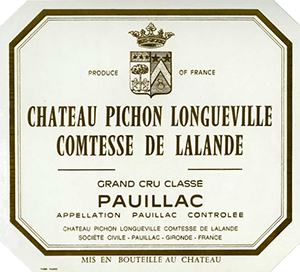| Region | |
|---|---|
| Subregion | France > Bordeaux > Left Bank > Pauillac |
| Colour | Red |
| Type | Still |
One of the great names of the Médoc and a true "super-second". Pichon Lalande is one of the most demanded wines of Bordeaux. It is especially popular in the Far East thanks to its slightly exotic, spicy character and plump ripe fruit and polished texture. The percentage of Merlot in the vineyard is high for Pauillac. The "Comtesse" is now owned by Champagne house Louis Roederer and managed by Nicolas Glumineau, formerly of Montrose. A new winery has just been built.

The 2017 Pichon Comtesse has a medium to deep garnet-purple color. It is quite closed to begin, opening out with considerable swirling to reveal a gorgeous perfume of raspberry coulis, red roses, and crushed rocks, leading to a core of cassis and blackberries, plus a hint of cedar. Medium-bodied, the palate is elegant and finely crafted, delivering very fine-grained tannins and seamless freshness, finishing with fantastic length.
Tasted blind. Deep ruby colour. Floral, cool and high-toned aromatics. Fragrant violets and blackcurrant. Compact yet intense, this is bursting with summer-pudding fruit. Darker cassis comes with bright acidity through the mid palate, which finishes fresh but long. The tannins are fairly gentle, allowing the fruit to shine, but there are plenty there for ageing potential. A subtle example that might shine even more when tasted in isolation.
Drink 2026 – 2039
A tight, compact young Bordeaux with medium body, polished and round tannins and a medium finish. Not a big wine, but some very classy currant and raspberry character and just a hint of lead pencil and polished structure. Drink after 2022.
If you just taste the big name Pauillacs, you would be hard-pressed to understand that 2017 has been a challenging year. This is one of my wines of the vintage, no question. It's from 21ha, biodynamically farmed, with Vincent Masson as consultant. Just a few plots further away from the river were affected by frost. The slight austerity of 2017 is evident, with a savoury quality to the fruit, but this is exceptionally good, with plenty of stunning fruit and well defined tannins. The aromatics are very refined, and the intense cassis fruit doesn't sacrifice any intensity or power. It demonstrates the energy that Comtesse has displayed so consistently in recent vintages, with gorgeous finesse and structure to the tannins. The new cellar has raised the level of Cabernet from 65% to 70+%, with 12% press wine. This is going to age extremely well.
Drinking Window 2026 - 2040
Dark crimson with soft pink rim. Lightly leafy dark fruit. Super-smooth texture and some fruit sweetness on the mid palate. Firm, dark and elegant on the finish. Sinewy and quite supple and long even without huge intensity, showing the charm of Comtesse and still clearly revealing its Pauillac origins. A smart, elegant wine reflecting the vintage. Tannins are tender – if more serious than on the Réserve de la Comtesse – and fruit just right.
Drink 2027-2042
Woodland violets the nose has fragrance freshness the palate depth of flavour ripe black fruits black cherry all backed by dark chocolate. There is an underlying fresh streak the finish has stylish length. Drink 2027-2041.
Very clean and firm, there is a singular theme here. The Cabernet Sauvignon is so pure and dominant that while the other varieties clearly add detail, they are lined up behind the silhouette of the Cabernet and for the time being, they have to wait to add their voices to the experience. Very satisfying and very clean, this is a wonderful expression of this property and also the vintage.
This is a really fascinating young Pichon Lalande with a dense center palate of currants, crushed stones, salt and seashells. Really long and intense. Wonderful energy. Showing character of some of the top years of the 1980s.
Composed of 70% Cabernet Sauvignon, 23% Merlot, 6% Cabernet Franc and 1% Petit Verdot, the 2017 Pichon Longueville Comtesse de Lalande has a medium to deep garnet-purple color and is a little closed to begin, soon revealing floral notes of lilacs and lavender over a core of black raspberries, warm blackberries and forest floor plus touches of star anise and stewed black tea. Medium-bodied, the palate is a bundle of energy and tension with softly played tannins and beautiful floral and black fruit layers, finishing with a long-lingering whisper.
Drink Date
2021 - 2049
This barrel sample is 100% new oak, whereas the final blend will be only 60% new oak. A blend of 70% Cabernet Sauvignon, 23% Merlot, 6% Cabernet Franc and 1% Petit Verdot, the 2017 Pichon Longueville Comtesse de Lalande is very deep garnet-purple in color with an incredibly fragrant nose of roses, lavender and baking spices over a core of crushed blackcurrants, wild blueberries and fresh plums plus touches of iron ore and underbrush. Medium-bodied and elegant with firm, grainy tannins, it's quite taut and muscular, with lots of perfumed and mineral layers and a long finish with lingering cinnamon and anise notes.